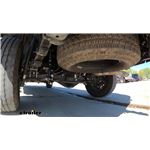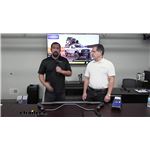Hellwig Adjustable Rear Anti-Sway Bar - 3/4" Diameter

Will this fit?
To see if this custom-fit item will work for you please tell us what vehicle you'll use it with.
- All Info
- Reviews (5)
- Q & A (0)
- Videos (2)
- Photos
2018 Toyota Tacoma - Hellwig Adjustable Rear Anti-Sway Bar - 3/4" Diameter
- Anti-Sway Bar
- Hellwig
- Rear
- Steel w Polyurethane Bushing
Minimize sway and improve the driveability of your truck. Solid, 3/4" chromoly sway bar provides improved handling and safety. Adjustable anti-sway bar lets you choose level of stiffness. For 4" to 6" lifts. Drilling required.
Features:
- Minimizes side-to-side movement to improve overall stability of your vehicle
- Lets you execute turns and quick maneuvers with confidence
- Allows for a level ride, even on irregular surfaces
- Reduces driver fatigue - minimizes effort required to keep your vehicle in line
- 3 Adjustment holes allow you to choose degree of stiffness
- Diminishes effects of crosswinds, passing motorists, and shifting cargo
- Made with polyurethane bushings for a longer-lasting system
- Durable and resistant to damage caused by oil, gasoline, and ozone
- Less wear means less give in the system and better support
- Includes zinc-plated mounting hardware, easy-to-follow instructions, and bushing lubricant
- Drilling required to install end links
- Constructed of thick 4140 chromoly steel for superior strength
- Sway bar finished in corrosion-resistant, silver vein hammer tone powder coat
- Mounting brackets and end links finished in corrosion-resistant, black powder coat
- Made in the USA
Specs:
- Bar diameter: 3/4"
- Limited lifetime warranty
Note: This kit requires drilling the frame rail and possible relocation of fuel and brake lines. Installer must ensure that the sway bar kit will not interfere with any fuel or brake lines or hoses.
7855 Hellwig Adjustable Rear Anti-Sway Bar - 3/4" Diameter
Installation DetailsCalifornia residents: click here


Videos are provided as a guide only. Refer to manufacturer installation instructions and specs for complete information.
Video Transcript for Hellwig Adjustable Rear Anti-Sway Bar Installation - 2023 Toyota Tacoma
Hello neighbors, it's Brad here at etrailer and today we're taking a look at installing the Hellwig rear sway bar on a 2023 Toyota Tacoma. Tacoma's are pretty comfortable trucks to drive normally and just kind of daily driving it, you're not gonna get a ton of sway in the vehicle just with factory suspension. You'll have a little bit, but nothing that really constitutes any suspension enhancements but ours today, we can have this set up for over landing. So we have a ladder rack back there. It's gonna be loaded up with a rooftop tent and that's where we're really gonna get that top heavy feel. So as you go around corners with all that added weight, the truck's gonna wanna sway side to side and that's where adding a rear sway bar comes into play.
I've done them on all of my own personal vehicles. I've always added a rear sway bar because you get the benefits of a nice clean turn, you get a lot more driver feedback through the wheel and just more confident driving overall, especially when you're adding weight to the back. This makes a lot of sense. So we're gonna take this out, see what it's like before. That way when we get our sway bar installed, we can see the difference.
So going through a parking lot, a lot of times with sway bars, people expect a difference in the ride quality, just going down the straight line and that's not the case. Your sway bar really only engages once you start to make the side to side movements. So when you do a turn without that suspension enhancement, you're gonna notice that it is just a little numb in the steering and it, again, especially once we're loaded up, it's gonna feel top heavy and that makes it to where it's not gonna really be able to bounce back right away and get the quick steering for counter. And I think this is definitely an addition to this vehicle that the owner's really gonna love and that's something that I recommended rear sway bars, not even Hellwig's, but just any sway bar addition to any vehicle makes a world of difference. Now you might notice that my shirt has changed, we've done this over a two-day period, but I'm here to tell you this is not an install that takes that long to do.
You can knock this out in your driveway or garage. I would say in maybe just a couple hours. But overall, it's totally worth doing. As I mentioned, putting a sway bar in any vehicle, whether it be an RV, a passenger vehicle, or a truck like this, it really just makes a huge difference. A lot of vehicles will already have sway bars installed from the factory.
We don't have a rear one here, so it's gonna make a huge difference. Now this one being three quarters of an inch in diameter, it seems pretty small, but it is enough to just kind of work together with the factory suspension. We also have airbags on here, but your leaf springs are also doing a fine job of kind of absorbing and this is just gonna help, add to that when it comes to sway control. So it's definitely gonna add to the entire suspension or handling package if you're doing upgrades. Putting a sway bar on our Tacoma is gonna take away from that standard truck feeling of having that lean and feeling top heavy, especially with the overland build like we have here. When you add weight to the top of the bed, all of that does make it more top heavy. So as you make those turns, the truck's gonna wanna lean side to side and this is gonna help plant it because as you lean, that sway bar's gonna push back, trying to center the vehicle and that's gonna translate to keeping the vehicle a little bit more flat. And that's a good thing because it's not gonna allow it to sway as much. So you're gonna get better steering, feel, better control overall, and just a better handling vehicle every time you drive it. Now going over bumps, you're not gonna notice it because this just goes vertical. It's when you make those turns, even a small turn you're gonna notice an instant difference. And I think you're gonna be really happy with it. And the Hellwig sway bar, the instructions are a little bit subjective as far as getting it all installed, but it's not too terribly hard to do and there's a lot of nice features. Minor drilling required to get this mounted up. The rest is kind of bolts around and it works really well with this. But you'll notice compared to a lot of other sway bars that you'll see under vehicles that are aftermarket, a lot of times they'll have a bright color or there'll be a gloss. This is a hammer tone finish So you can see that there's actually pits along here and that's not just for decoration. Not only does it hold up to chips and scratches long term, but also as you put grease on your urethane bushings, that's gonna cut down on friction and noise. But normally, with that gloss, it just kind of as they work, it pushes that grease out where this traps it in little pockets. So even as we tightened it down, a little bit of grease comes out and that's okay because a lot of it is still trapped in there and it's gonna stay in there as it moves because you have those pockets to hold that grease in place. So back out in the parking lot and we're gonna take a few corners here and see the difference that it makes. So our first turn, oh yeah, immediately it just feels a lot more confident in a small turn like that, which seems very minimal, but every turn that I make, it's just gonna be a little bit ready to go for that next turn. So I'll do some side to side slaloming here. I'll do a nice wide sweeper here. Oh yeah, the truck is way more planted. I'm not having to lean with it, it seems. It just stays flat. And so this turn, it's just keeping the truck nice and planted, it doesn't feel like it's just leaning hard to one side. It's still there a little bit, but huge difference. So now that we've seen our sway bar on the test course, let's show you how we installed it. To begin our installation, you might wanna take the spare tire out the back of your truck, lower that down and get it out the way. It's just gonna give you more real estate to work. Go ahead, grab your sway bar and also the bushings included. And we're gonna place these in this section here, roughly in about the middle. And we're gonna want to grease these up. And this is gonna be important. It's gonna cut down any squeaky long term and just make sure there's not a ton of friction. Now these are split, so you'll be able to slide these over the sway bar and especially with a little bit of grease in place, that'll help lubricate it. So put some of the grease in here and I recommend getting some nitrile gloves and just make sure the hole inside is coated up. And then we can just slide this on. You may have to kind of pry on this a little bit. It's pretty stiff here. There we go. And we'll get one on the other side as well. Now something else that I like to do is on the outside of the bushing, also coat this down. It's just a good potential to cut down any squeaking. Polyurethane is really, really good as far as holding up long term, but the one downside, especially when it gets to cold weather, is it will squeak a little bit. So just kind of putting some lubrication here is gonna hopefully help cut down on that. And we also wanna make sure that we get our hardware laid out 'cause we're gonna get this bolted up. And the way that we're gonna do that is we have our saddle clamps, our U-bolts. We also have the half inch washers, so we're gonna need two per U-bolt and then two hex bolts. Now make sure there's gonna be some locking ones included in the kit. Make sure that they're just the standard hex and we'll just get this laid up. And essentially what we're gonna do is we're gonna go around the axle with our U-bolt, it's gonna go onto the saddle plate and clamp around. And then our sway bar is going to bolt into here. So we'll get this kind of preassembled and raise it up in place. Now underneath the vehicle, we're kind of getting ready to get the sway bar mounted up and I grabbed my U-bolts and slid them around the axle. On the driver's side, I don't worry too much, we do have some lines here, but it seems like it's gonna clear everything just fine. Passenger side, we do have this hard line and I think we're best to just lightly bend this out of the way. You don't wanna put too much pressure or cause any big kinks in it and we can go back later and zip tie this up. But I would recommend probably running the U-bolt alongside the axle with these on top of it. And as we raise this up, that center bump out should go where the pumpkin on the depth is. And then we'll take our saddle plate here. I'm gonna slide this on, and at the same time I'm gonna take our sway bar with our bushing in it's bracket here, and we're just gonna get this started on one side, it'll hold itself up. So make sure you're putting the flat washer on first. And then we'll get our hex nut just kind of started on the top and bottom to support it. We'll just go ahead and repeat the same process on the other side. So we have this loosely attached and we're gonna leave it that way. We're gonna want a little bit of a adjustability. So for now, we'll leave this hanging. Now, we'll get our end links assembled here. So first take the large nut that should thread on here and we're just gonna back this down for now. And that will thread into the other end of the unlink. We're then gonna apply a little bit more grease. We're gonna be putting these hourglass shape bushings that are polyurethane in place here, but we're gonna want to grease those. So go ahead, grab some gloves and we'll get these popped in. So we'll lubricate these. And once it's all coated, we'll just press this into each of the ends. So we'll do this for all four of them. This with a little pressure, we should be able to get this to pop in. And it's gonna sit like that. Now once you have one pressed in, we're also gonna take this metal sleeve or collar, and we're gonna lubricate the outside of this too. And this should just slide in here. You may have to kind of press that in as well. And we got that pressed in place. So we'll just repeat for the remaining three openings. The instructions aren't super clear at this point. There's three holes on the sway bar and adjusting them to different spots will adjust how tight or stiff it is. We're gonna go in the middle just to kind of have a nice little baseline here. So to get this in place, you'll see this larger outer portion of your end link. We're gonna take that and run our bolt with our washer through. This will then go to the sway bar where we're gonna finish it up with washer, and then we have our lock nuts. Now this is also just gonna go in place for now. We're not gonna tighten this down, but make sure you have that locking nut here. And we'll get the other side in place as well. Now with the end link attached to the sway bar, we're also gonna get our bracket in place. And eventually, this is going to mount up to the frame rail and that's gonna become our stud to become a structural mount for the sway bar to counteract. Now, you may notice on the bracket, there's gonna be a larger hole and a smaller hole. We're gonna be using the smaller hole to bolt this up. So the end link's gonna rotate so it really doesn't matter which end you put it on. So we'll just slide this in with our flat washer and then we'll finish it up with another flat washer on this side, and then a lock nut. They didn't clarify exactly which one to use, but we're gonna go ahead and do it this way and see how it works. Now I'm using the lock nut here. They're not very clear in the instruction manual, but I think this is gonna work well for us. And considering that we used them on this other portion of the end link, I think we're gonna go ahead and do that. So we'll get this one in place. We'll go ahead and repeat the same step on the other side. So through the instructions, they want you to raise this up to where it's in position and the bars are nice and even. We can get that dialed in a little bit later, but we do need to create a hole for our brackets to be able to bolt through. And if you look where the cross member sits on the frame, there's these two rivets here that are holding it all together and we're gonna be going right in the center and a little bit offset towards the outside of the frame with a half inch drill bit. Now I recommend using a punch here just to create a nice spot. That way it's not rolling around on the frame. And if you need to, you can start with a small drill bit and kind of work your way up. But eventually, as you're drilling through, you're gonna wanna make sure that your hardware is able to pass through. So maybe keep this handy as you're drilling out and just make sure that that passes through nice and clean. So we'll go ahead, we'll get this drilled out. (drill drilling) I'm just gonna go a little bit bigger here just to make sure what this passes through. And then we'll just repeat on the other side. Adjusting the sway bar does come with a little bit of steps here. We had everything loose so we can move it around and that's great, but when we're trying to dial it in, it can get a little funky. So what we're looking for is our sway bar to be parallel with the ground. So this should sit obviously parallel with the ground there. This bracket and end link needs to sit vertical. So what I think I'm gonna do is probably measure this so we can compare both sides and make sure that that's even. We'll get that vertical, and then we still have some adjustment here where our U-bolts go around. So I think I'm gonna kind of use that as my final adjustment. We can always come back and adjust it as necessary. But for now, what I'm gonna do is measure from where our threads are and just make sure that it's even on both sides here. So right at the weld there, I'm gonna go with four inches and that should get us pretty close. And we'll just draw this in a little bit more until we get that four-inch mark. That's pretty close. We'll make sure we get our bracket on the proper spot. So I'll just do one more rotation here. And I think that'll be good enough to at least get this bolted up and we can fine tune everything else in the process. To get our end link attached, we'll just take our bolt that we have here with a flat washer and we're gonna drop this down, we'll raise this end link up, and then we're gonna finish this with flat washer and then a lock nut here. And then we'll go ahead and get the other side attached as well. So while we have everything kind of bolted up, this is a good time. I'm gonna center everything up as much as I can. So our sway bar, we should sit kind of in the middle here with our bushing. So adjust this as necessary, find a reference point to measure to make sure they're even on both sides. And I think what we're gonna do is I'll just pull this sway bar back and kind of pitch it at where I think normally it should go based on other vehicle's sway bars. And just kind of holding this in place, I'll snug these down first and then we can kind of work our way up. So just make sure that this is nice and parallel to the ground. And then also center it up before tightening down. I have a 19, three quarter socket here, so I'll just start snugging down. With U-bolts, you kind of go back and forth. So don't go too much on one. You wanna make sure it's a nice even. (drill drilling) And a good rule of thumb is just kind of follow the threads, make sure that they're even on both sides. (drill drilling) Next I'm gonna tighten down my brackets, just making sure that they're squared up with the frame so it's all lined up nice and perpendicular. We can always adjust the end lengths and in fact we're probably gonna end up having to do that regardless. So I think tightening this down, as well as those U-bolts is gonna give us a nice, just baseline to get this all dialed in. So you're gonna need a wrench up top as well as a socket on the bottom. I'm using a 19, and we'll go ahead and get this snug down. (machine revving) So at this point, we'll go ahead, we're gonna get our end links tightened up, make sure that they're nice and even from side to side. And then once we're happy with that, we're gonna go back with a torque wrench and all of these will have a torque setting, so make sure that you get them all torqued down properly. Now, at this point, it's a good chance to get our end links kind of in place where we have our sway bar as level with the ground as possible. So kind of getting this set up, that middle hole worked pretty well to get us at least kind of dialed in. But to get these as vertical as possible, I think using the forward most hole is gonna be key. But we also wanna make sure that we extend this out to where it's not binding it up one side to the other. So kind of adjust this if you need to. You can just kind of thread this out a bit. Now once you're happy with it, you'll have your jam nut up here and that's gonna tighten down to hold it in place. And then on our end link where it attaches to the sway bar, we'll just finish it up with a flat washer and then our lock nut, I'll just make sure I get the other side dialed in exactly the same as this one. And then we can get this tightened down. Now once you're happy with everything, the jam nut, I use a 22 millimeter wrench to tighten that down. And our bolt on the bottom here, I have two different sockets. I got 11/16" for the nut side and then at 5/8" for the head of the bolt. And there's no torque settings here, but what you're gonna be looking for is you want it to make contact and start to squish the bushing, but you also don't want to overtighten it. You want to have a little bit of, obviously movement that it can allow. So I'll just snug this down. (machine whirring) We have contact there. So just a few more bumps here (machine whirring) And once you kinda get that to where you can see it, it is kind of, it is squishing it down a little bit. But also if you go too tight, it's gonna not really allow for this to pivot and move. So I think I'm happy with this. And something that you're gonna want to do over time is once you drive around, it's gonna wanna move around and loosen. So go back and tighten these down once you've driven around a little bit. And you can also make adjustments as necessary. So if you want a little bit stiffer, you can move it towards the front of the vehicle. If you want it a little less stiff, it's a little softer, you can move that back as necessary. It's kind of up to you on dialing it in. And that was a look and installation of the Hellwig rear sway bar on a 2023 Toyota Tacoma.
Customer Reviews
Hellwig Adjustable Rear Anti-Sway Bar - 3/4" Diameter - HE38YR
Average Customer Rating: 4.4 out of 5 stars (5 Customer Reviews)
Minimize sway and improve the driveability of your truck. Solid, 3/4" chromoly sway bar provides improved handling and safety. Adjustable anti-sway bar lets you choose level of stiffness. For 4" to 6" lifts. Drilling required.Didn't fit my vehicle as specified, had to use adapter and longer bolts.
love the service
Good product
Works well
See what our Experts say about this Hellwig Anti-Sway Bars
- Recommended Anti Sway Bar For A 2023 Toyota TacomaWe can definitely set you up with sway bars for the front and rear of your 2023 Toyota Tacoma with a 4" lift. For the front I recommend the Hellwig # HE58GR. This is a 1-3/8" diameter steel sway bar that will replace the factory sway bar. You will reuse the factory end links for this one. For the rear, I recommend the Hellwig # HE38YR. This is a 3/4" bar and includes extended end links to accommodate for the 4" lift on your Tacoma. This one will require drilling into the frame, and possible...
view full answer...
Info for this part was:






At etrailer.com we provide the best information available about the products we sell. We take the quality of our information seriously so that you can get the right part the first time. Let us know if anything is missing or if you have any questions.















Thank you! Your comment has been submitted successfully. You should be able to view your question/comment here within a few days.
Error submitting comment. Please try again momentarily.